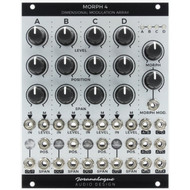Morph 4 - Joranalogue
by Brandon Ivers
I’m guessing if you’re reading this magazine, you’ve already heard the cliche “you can never have enough VCAs” by now. If not, allow me to reiterate the truth of that statement. VCAs allow for so many classic effects like ring modulation, right down to more mundane but no-less-useful utility tasks like mixing or volume control, and it is absolutely essential to have at least a couple of them in a case. That said, because VCAs are so common, sometimes it’s easy to miss when they’re presented in novel ways. Joranalogue’s Morph 4 very much falls into this category. You can naively use it as four separate VCAs, but the ability to modulate and “morph” between each VCA and the many different mixing outputs available turns it into something both novel and capable of changing how you think about your modular.
Like all Joranalogue modules, the Morph 4 is incredibly well-built with a tough front panel, excellent knobs, and an overall build that feels substantial and carefully designed. It’s a fairly large module at 20hp, but I think it’d be too cramped if it was any smaller. There are tons of LEDs that display VCA output levels as well as modulation source levels, and once you understand the morphing concept of this module, the controls are intuitive and don’t really require reading the manual later on.
The general idea of morphing is that you can modulate the Morph 4’s “morph” value along an x-axis. Each VCA has a “position” and “span” value that sets a center point along that axis [aka position] and how wide of an area it covers [aka span]. The Y-axis is ‘level’, so if you set a VCA’s span and position knobs right in the middle, when turning the morph knob to the middle, that VCA will output at full level. As you morph to the left or right, the VCA will decrease in level via a linear ramp, which the manual refers to as “triangular”.
You can externally modulate any of the VCA’s span and position values, you can modulate the morph position, and you can modulate each VCA’s level, so basically everything worth modulating can be. You can individually output each VCA, but there are also A+B and C+D mixes of the VCA pairs, and ADD, AVG, MIN, and MAX outputs as well. Some of these outputs lend themselves better for CV modulation than say, as oscillator, but they all have their uses.
Perhaps the most obvious [dumb?] use for the Morph 4 is novel mixing of oscillators and effects. Similar to some other X-Y mixer modules like Intellijel’s Planar, if you input several oscillators into the Morph 4 and scan through them with the ‘morph’ value, you can get interesting oscillator blends that can be modulated at audio rate. I’m not even sure if there is a proper term for the sort of effect this achieves, but having an oscilloscope handy will show you all manner of bizarrely mixed waveforms that can be further twisted via the various mixing outputs. The MAX and MIN outputs, for example, will give you the positive or negative outputs of a signal, so you can use half-wave rectification to make new waveforms [i.e when you want the positive values of a sine wave, but the negative values of some other waveform]. Sure that seems weird but it just goes to show that you can extend this module to bizarre places very easily if you want.
I had a ton of fun running two stereo effects [a Make Noise Mimeophon and a Grayscale Supercell] into the Morph 4, and modulating the mix of those effects via ‘morph’. Because the effects are both stereo, when you morph through values at a faster LFO rate, you can get wild mixtures of each effect that pan through the stereo field in pretty wild ways. For effects that seem a bit static, morphing like this gives a ton of movement and a lot of happy accidents.
The Morph 4’s manual also guides you through several esoteric effects that can be achieved that I never would have thought of. For example, if you plug a waveform into the morph input rather than one of the VCA inputs, you’ll get [potentially] bizarre and complex variations of that waveform via the mixing outputs. This is because channel A has a +5 V input normal. I found this very clever and absolutely the kind of thing that rewards randomly plugging things into jacks and seeing what happens.
I probably wouldn’t recommend the Morph 4 for smaller cases, however, if you have the room to work with, the module is 8 hp larger than many of the other four VCA combos out there, and it can do so much more. I found myself often splitting tasks within the module, since you can easily use the first couple channels for simple VCA duties and leave the other two for morphing, as long as you understand how ‘span’ and ‘position’ work.
Overall, I just love the stuff that Joranalogue does and this module is no exception—it’s a somewhat unusual take on the quad VCA idea, but it can lead to some really wild results that would take a lot more modules and brainpower to achieve by other means. Highly recommended for lovers of ring modulation, CV mixing, odd waveshaping, and modules that can go on the road without too much stress.
20 HP +12v 110mA -12v 110mA
Price: $350


